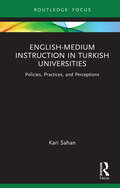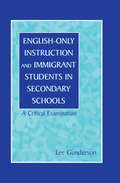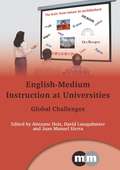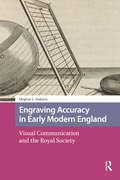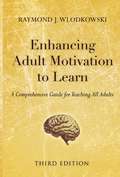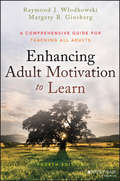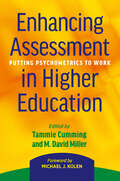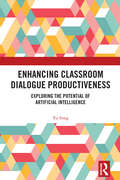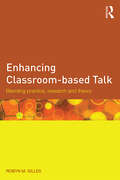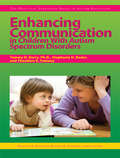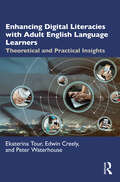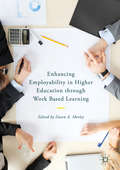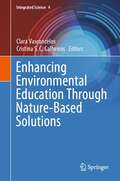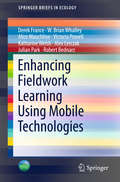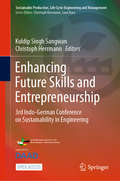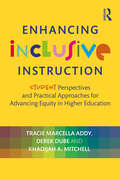- Table View
- List View
English-Medium Instruction in Chinese Universities: Perspectives, discourse and evaluation (Routledge Critical Studies in Asian Education)
by Jing Zhao L. Quentin DixonThis edited book is about the rationale, practice and classroom implementation of English-medium instruction courses in Chinese universities. It specifically focuses on classroom discourse analysis across different disciplines and settings. The main themes of this book are: describing the state educational policies toward English-medium instruction at the tertiary level; distinguishing English-medium instruction from mainstream foreign language learning; analyzing curricula and discourse at the classroom level and evaluating the learning effectiveness of these courses. This book covers the widespread implementation of English-medium courses in China across different disciplines, and it provides a window for researchers and practitioners from other parts of the world to see the curriculum design, lesson planning, discourse features and teacher-student interaction in English-medium classrooms in China. Contributors to this volume consists of a panel of highly respected researchers in the fields of bilingual education, English-medium instruction, classroom discourse analysis and language program evaluation. Chapters include, Balance of Content and Language in English-Medium Instruction Classrooms English-Medium Instruction in a Math Classroom: An Observation Study of Classroom Discourse Asking and answering questions in EMI classrooms: What is the Cognitive and Syntactic Complexity Level?
English-Medium Instruction in Turkish Universities: Policies, Practices, and Perceptions (Routledge Focus on English-Medium Instruction in Higher Education)
by Kari SahanIn response to the growing use of English as an international language, the number of English-medium instruction (EMI) programs in higher education has increased. However, decisions to implement EMI programs are often made through top-down policymaking processes with little consideration for the educational issues surrounding language policy changes.This book examines the variation with which EMI is implemented at universities in Turkey through a multilevel empirical investigation of policies, practices, and perceptions. In addition to providing a sociohistorical overview of EMI in Turkey, the book draws on a dataset that includes policy documents, classroom observations, interviews with teachers, and focus group discussions with students. Despite national policies which envision a "one-language-at-a-time" model of EMI education, this book argues that EMI is neither English-only nor English-always in practice. By highlighting the variation with which EMI is implemented at and across Turkish universities, this study illustrates the need for more comprehensive EMI policies and processes aimed at integrating content and language learning in higher education.Implications are discussed with respect to policy planning, program development, and pedagogical support and will be relevant for researchers and postgraduate research students interested in EMI, particularly in the Turkish context.
English-Only Instruction and Immigrant Students in Secondary Schools: A Critical Examination
by Lee GundersonThis book is for teachers, teacher educators, school and district administrators, policy makers, and researchers who want to know about literacy, cultural diversity, and students who speak little or no English. It offers a rich picture of the incredible diversity of students who enter secondary school as immigrants—their abilities, their needs, and their aspirations. The studies reported are part of a large longitudinal study of about 25,000 immigrant students in a district in which the policy is English-only instruction. These studies:*provide multiple views of the students’ lives and their success in schools where the language of instruction differs from the languages they speak with their friends and families;*explore the students’ views of teaching and learning; *describe the potential differences between the students views and those of their teachers; *look at issues related to students’ views of their identities as they work, study, and socialize in a new environment; and*examine different reading models designed to facilitate the learning of English as a second language (ESL). Educators and researchers will find the descriptions of students’ simultaneous learning of English and of academic content relevant to their view of whether instruction should be English only or bilingual. For teachers who view multicultural education as an important endeavor, this book may on occasion surprise them and at other times confirm their views. The author does not attempt to develop a particular political viewpoint about which approach works best with immigrant students. Rather, the objective of the studies was to develop a full, rich description of the lives of immigrant high school students enrolled in classes where the medium of instruction is English. The reader is left to evaluate the results.
EnglishMedium Instruction at Universities
by Aintzane Doiz David LasagabasterThis book provides critical insights into the English-medium instruction (EMI) experiences which have been implemented at a number of universities in countries such as China, Finland, Israel, the Netherlands, South Africa, Spain and the USA, which are characterised by differing political, cultural and sociolinguistic situations. In particular, it reflects on the consequences of implementing EMI as an attempt to gain visibility and as a strategy in response to the need to become competitive in both national and international markets. The pitfalls and challenges specific to each setting are analysed, and the pedagogical issues and methodological implications that arise from the implementation of these programmes are also discussed. This volume will serve to advance our awareness about the strategies and tools needed to improve EMI at tertiary level.
Engraving Accuracy in Early Modern England: Visual Communication and the Royal Society (Scientiae Studies)
by Meghan DohertyEngraving Accuracy in Early Modern England traces major concepts including: the creation of the visual effects of accuracy through careful action and training; the development of visual judgment and connoisseurship; the role of an epistolary network in the production of knowledge; balancing readers' expectations with representational conventions; and the effects of collecting on the creation and circulation of knowledge. On the one hand, this study uncovers how approaches to knowledge production differed in the seventeenth century as compared with the twenty-first century. On the other, it reveals how the early modern struggle to sort through an overwhelming quantity of visual information - brought on by major changes in image production and circulation - resonates with our own.
Enhancing Adolescents' Motivation for Science: Research-Based Strategies for Teaching Male and Female Students
by Lee B. Shumow Jennifer A. SchmidtBecause motivation is the key to scientific literacy Within every science classroom there are students waiting to be inspired. All these students need is the right motivation. That’s exactly what this one-of-a kind guide will help you provide. And along the way, you’ll quickly learn that the motivational tools that are most effective with adolescent boys don’t always work with adolescent girls—and vice versa. Part book, part website, this resource • Details research-proven motivational constructs specific to science • Addresses gender differences that influence motivation • Describes how to make science learning relevant and enjoyable • Builds confidence, especially among girls • Offers motivational strategies that are consistent with the NGSS
Enhancing Adult Motivation to Learn
by Raymond J. WlodkowskiNew to this edition is the blending of a neuroscientific understanding of motivation and learning with an instructional approach responsive to linguistically and culturally different adult learners. Based on the most current educational and biological research, Enhancing Adult Motivation to Learn addresses issues that focus on deepening learner motivation and helping adults to want to learn. In the book, Raymond J. Wlodkowski offers a clear framework and sixty practical, research-based strategies that are designed to elicit and encourage learner motivation. In addition, the book is filled with practical examples, guidelines for instructional planning, and cutting-edge ideas for assessment and transfer of learning.
Enhancing Adult Motivation to Learn: A Comprehensive Guide for Teaching All Adults
by Raymond J. Wlodkowski Margery B. GinsbergThe classic interdisciplinary reference on adult education, updated for today's learning environment Enhancing Adult Motivation to Learn provides adult educators with the information and strategies they need to guide non-traditional students toward positive educational outcomes. Providing a clear framework, guidelines for instructional planning, real-world examples, and cutting-edge ideas, this book fills the need for intrinsically motivating instruction targeted specifically toward adults returning to school. This new fourth edition sharpens the focus on community colleges, where most first-generation college students and working adults begin their higher education, and explores the rising use of technology and alternative delivery methods including a new chapter covering online instruction. Since the publication of its first edition, this book has become a classic reference for understanding adult motivation in educational and training settings. As more and more adults re-enter the educational system, instructors and trainers will find extraordinary value in this exploration at the intersection of research and practice. Examine the latest neuroscience and psychological research pertaining to adult motivation and learning Delve into alternative formats including online learning, interactive learning materials, and more Elicit and encourage adult intrinsic motivation using the Motivational Framework for Culturally Responsive Teaching and sixty practical, research-backed strategies Adopt a culturally responsive instructional approach for an inclusive and equitable learning environment. Adult students differ from traditional students in motivation, attitude, experience, and more; this, combined with an increasingly diverse body of students as well electronic delivery methods, makes today's teaching environment a new landscape for instructors to navigate. Enhancing Adult Motivation to Learn provides a clear guide to success for instructors and students alike.
Enhancing Assessment in Higher Education: Putting Psychometrics to Work
by Tammie Cumming M. David MillerCo-published with AIR.Published in association with Assessment and accountability are now inescapable features of the landscape of higher education, and ensuring that these assessments are psychometrically sound has become a high priority for accrediting agencies and therefore also for higher education institutions. Bringing together the higher education assessment literature with the psychometric literature, this book focuses on how to practice sound assessment.This volume provides comprehensive and detailed descriptions of tools for and approaches to assessing student learning outcomes in higher education. The book is guided by the core purpose of assessment, which is to enable faculty, administrators, and student affairs professionals with the information they need to increase student learning by making changes in policies, curricula, and other programs.The book is divided into three sections: overview, assessment in higher education, and case studies. The central section looks at direct and indirect measures of student learning, and how to assure the validity, reliability, and fairness of both types. The first six chapters (the first two sections) alternate chapters written by experts in assessment in higher education and experts in psychometrics. The remaining three chapters are applications of assessment practices in three higher education institutions. Finally, the book includes a glossary of key terms in the field.
Enhancing Beginner-Level Foreign Language Education for Adult Learners: Language Instruction, Intercultural Competence, Technology, and Assessment (Routledge Research in Language Education)
by Ekaterina NemtchinovaThis book is an authoritative text that explores best classroom practices for engaging adult learners in beginner-level foreign language courses. Built around a diverse range of international research studies and conceptual articles, the book covers four key issues in teaching language to novice students: development of linguistic skills; communicative, and intercultural competence; evaluation and assessment; and the use of technology. Each chapter includes teaching insights that are supported by critical research and can be practically applied across languages to enhance instructional strategies and curriculum designs. The text also aims to build intercultural competence, harness technology, and design assessment to stimulate effective learning in formal instructional settings including colleges, universities, and specialist language schools. With its broad coverage of language pedagogy at the novice level, this book is a must read for graduate students, scholars, researchers, and practitioners in the fields of language education, second language acquisition, language teaching and learning, and applied linguistics.
Enhancing Biomedical Education: Integrating Digital Visualization and 3D Technologies (Biomedical Visualization #7)
by Flora GröningThis edited book explores digital visualization as a tool to communicate complex and often challenging biomedical content in an accessible and engaging way. The reader will learn how current visualization technology can be applied to a wide range of biomedical fields to benefit the learning of students and enhance the public understanding of science. The focus of this volume will be on the innovative use of digital visualization (2D or 3D) in biomedical education and public engagement. This includes medical imaging (i.e., magnetic resonance imaging and computed tomography) as well as other digital imaging techniques such as laser scanning. It also covers the use of state-of-the-art visualization tools (i.e., augmented and virtual reality, animations and 3D printing) and the integration of 3D models of anatomical structures into serious computer games. This book will appeal to educators, researchers and students in life science subjects as well as to healthcare professionals and designers of digital learning resources. The book will be a source of inspiration for any reader who is interested in using digital visualization as a meaningful and engaging communication tool for biomedical content, ranging from the anatomy and function of organs to the mechanisms of diseases and their prevention.
Enhancing Campus Capacity for Leadership
by Adrianna J. Kezar Jaime LesterEnhancing Campus Capacity for Leadershipexplores a mostly untapped resource on college campuses - the leadership potential of staff and faculty at all levels. This book contributes to the growing tradition of giving voice to grassroots leaders, offering a unique contribution by honing in on leadership in educational settings. In an increasingly corporatized environment, grassroots leadership can provide a balance to the prestige and revenue seeking impulses of campus leaders, act as a conscience for institutional operations with greater integrity, create changes related to the teaching and learning core, build greater equity, improve relationships among campus stakeholders, and enhance the student experience. The text documents the stories of grassroots leaders, including the motivation and background of these "bottom up" beacons, the tactics and strategies that they use, the obstacles they overcome, and the ways that they navigate power and join with formal authority. This investigation also showcases how grassroots leaders in institutional settings, particularly more marginalized groups, can face significant backlash. While we like to believe that organizations are civil and humane, the stories in this book demonstrate a dark side with which we must reckon. The book ends with a discussion of the future of leadership on college campuses, examining the possibilities for shared and collaborative forms of leadership and governance.
Enhancing Classroom Dialogue Productiveness: Exploring the Potential of Artificial Intelligence
by Yu SongThis book demonstrates how artificial intelligence (AI) can be used to uncover the patterns of classroom dialogue and increase the productiveness of dialogue.In this book, the author uses a range of data mining techniques to explore the productive features and sequential patterns of classroom dialogue. She analyses how the Large Language Model (LLM) as an AI technique can be adapted to enhance dialogue contributions. The book also includes valuable feedback and practical cases from teachers and their dialogue transcripts, facilitating an understanding of AI use and pedagogical development.This book makes original contributions to the field of classroom dialogue and technology, and it will encourage scholars making similar attempts at technological infusion for pedagogical improvement.
Enhancing Classroom-based Talk: Blending practice, research and theory
by Robyn M. GilliesEnhancing Classroom-based Talk provides an overview of the major research and theoretical perspectives that underpin the development of classroom-based talk. It outlines specific dialogic strategies and elaborates on the key role that teachers play in promoting interactions, challenging thinking and scaffolding the learning of students. While it is important to know how different dialogic approaches can enhance students’ interactions and learning and the effects they have on students’ social, emotional and cognitive development, it is also important to understand how students’ interactions promote understanding and learning during small group discussions. Throughout the book, teachers will be shown how to embed different dialogic approaches in their classrooms to promote discourse, with chapters covering: Interest in classroom-based talk The teacher’s role in promoting dialogue in the classroom Dialogic approaches to teaching Strategies to promote students’ interactions, thinking and learning Help seeking and help giving behaviours Creating environments that promote classroom-based talk Enhancing Classroom-based Talk will be a valuable asset to all those concerned with promoting classroom-based talk, as well as postgraduate students, teachers and academics who are regularly called upon to assist in developing classroom interventions that provide for the academic and social needs of students.
Enhancing Communication in Children With Autism Spectrum Disorders
by Tammy D. Barry Stephanie H. Bader Theodore S. TomenyEnhancing Communication in Children With Autism Spectrum Disorders presents an overview of impairments in communication among children with an ASD. A variety of techniques for implementing interventions are highlighted including applied behavior analysis, token economy systems, social skills groups, and more.
Enhancing Creativity Through Story-Telling: Innovative Training Programs for School Settings (Palgrave Studies in Creativity and Culture)
by Alessandro Antonietti Paola Pizzingrilli Chiara ValentiThis book examines the evidence-based interventions that can be used to promote creative thinking skills for children and adolescents in schools. It begins by explaining the theoretical basis of these training programmes, before presenting a coherent framework for the application of creativity theory in education. The authors describe and analyse programmes that have drawn on this framework, before offering an overview of the results of experimental studies which have validated the authors’ approach. This book provides practical guidance on how the programmes can be applied in the classroom and discusses potential future directions for research and practice for increasing children’s creativity. This book will be a valuable resource for teachers and teacher trainers, as well as to researchers in the psychology of creativity, education, and educational psychology.
Enhancing Digital Literacies with Adult English Language Learners: Theoretical and Practical Insights
by Peter Waterhouse Edwin Creely Ekaterina TourOffering a new perspective on adult English language education, this book provides theoretical and practical insights into how digital literacies can be included in the learning programmes for newly arrived adults from migrant and refugee backgrounds. Enhancing Digital Literacies with Adult English Language Learners takes readers inside Langfield, an adult community-based English language centre that supports the settlement and learning of this vulnerable group. Drawing on a six-month ethnographic study of Langfield’s work, the book explores the approach to teaching digital literacies and presents a range of perspectives, including those of the adult learners, the teachers, and the organisation’s CEO. The chapters present a holistic view of teaching digital literacies in the adult English language context by exploring: adult learners’ digital literacy practices in everyday life and their learning at Langfield; teachers' beliefs and practices about digital literacies; and the support offered to them through institutional resources, leadership, and professional learning. The book identifies exemplary practices, as well as areas for further development in Langfield’s work and offers a range of implications for practice, policy, and research. Written in a detailed but accessible manner, this book contributes important insights into the strengths and needs of this unique and complex education sector. Addressing an area of uncertainty for many researchers, practitioners, leaders, and policy makers working within community-based learning contexts in Australia and internationally, this book will be an essential resource.
Enhancing Digital Literacy and Creativity: Makerspaces in the Early Years
by Jackie Marsh Kristiina Kumpulainen Alicia Blum-RossEnhancing Digital Literacy and Creativity is an exploration of how young children gain digital literacies in ‘makerspaces.’ The international authors investigate how hands-on experimentation with a variety of materials - from traditional arts and crafts to contemporary digital tools like 3D printers and laser cutters - can aid children in their development of play, creativity and storytelling. From museums to libraries, nursery schools to community centres, this research shows how ‘making’ supports the development of creative skills and introduces concepts to be explored in a variety of environments and contexts. Drawing on examples from around the globe, described by a range of international academics, Enhancing Digital Literacy and Creativity includes chapters on: Virtual reality Museum and library makerspaces Intergenerational making in families Making in schools and nursery settings Assessing learning in makerspaces Links to previous theories Social imagination This book will be a valuable resource for students and researchers in the fields of education and digital literacies; early childhood teacher educators and practitioners; librarians; museum educators; and makerspace staff.
Enhancing Employability in Higher Education through Work Based Learning
by Dawn A. MorleyThis book focuses on a renewed interest in work based learning in higher education. Due to an increased emphasis on employability in the graduate population, supported by wider policy changes, work based learning is becoming an increasingly pressing issue in higher education. The authors detail innovations from a breadth of UK universities, where academics have creatively addressed changes in work based learning structure, pedagogy and support systems. These changes in turn recognise the impact of real-life learning experiences on student progression, on both an academic development and a personally transformative level. Encompassing a wide variety of topics, the examples within the book are supported by theory and carefully detailed practice pedagogy. This valuable edited collection will be of interest to practitioners and scholars of work based learning and higher education, as well as a useful practical guide for academic developers.
Enhancing Entrepreneurial Mindsets Through STEM Education (Integrated Science #15)
by Sila Kaya-Capocci Erin Peters-BurtonEntrepreneurship is defined in different fields with definitions ranging from a specific perspective such as starting a business to a broader perspective such as a process of establishing new social, economic, environmental, institutional, cultural and/or scientific environments. There has been some movement toward entrepreneurship in STEM education through hackathons and makerspaces, but they tend to be limited to informal settings. In higher education, there seems to be a border line between business schools and education departments. This book aims to remove the borders between the Business Schools and the Department of Education and help Business Schools to develop their educational practices further and help Education Departments to develop their knowledge of entrepreneurship from its formal discipline.The purpose of this book is to bring together experts from STEM education and the formal discipline of entrepreneurship to explore the role of STEM in everyday life through an entrepreneurial lens and show how this integration can broaden STEM education practices.
Enhancing Environmental Education Through Nature-Based Solutions (Integrated Science #4)
by Clara Vasconcelos Cristina S. C. CalheirosThis Book presents innovative and state of the art studies developed in Environmental Education in different countries to highlight this theme and promote its implementation all over the world. It will give a scientific perspective of Nature-based solutions to promote environmental education in all citizens and a more educational perspective as to how this approach can be implemented at schools and universities. Not less important is that includes science communication as a key factor for training and disseminating about the environment. The invited authors are recognized experts with excellent work developed in Environmental Education.This contributed volume presents innovative and creative work in the area giving a step forward in the implementation of Environmental Education, namely as a target of 2020 United Nations Agenda for Sustainable Development. The invitation of authors from many different countries allows the creation of a network and subsequently the book will bring concrete ideas as to how to develop operational capacities to bring added values to Environmental Education at an international level.
Enhancing Fieldwork Learning Using Mobile Technologies
by Robert Bednarz Derek France W. Brian Whalley Alice Mauchline Victoria Powell Katharine Welsh Alex Lerczak Julian ParkThis book shows how tablets (and smartphones) using a variety of selected 'apps', can enhance fieldwork and other out-of-classroom activities. The authors review imaginative uses of tablets from their own project and as well as examples from other colleagues. To help readers keep abreast of new technology and innovative ways to use it, the book is supported by a web site and a social media community.
Enhancing Future Skills and Entrepreneurship: 3rd Indo-German Conference on Sustainability in Engineering (Sustainable Production, Life Cycle Engineering and Management)
by Christoph Herrmann Kuldip Singh SangwanThis open access book presents the proceedings of the 3rd Indo-German Conference on Sustainability in Engineering held at Birla Institute of Technology and Science, Pilani, India, on September 16–17, 2019. Intended to foster the synergies between research and education, the conference is one of the joint activities of the BITS Pilani and TU Braunschweig conducted under the auspices of Indo-German Center for Sustainable Manufacturing, established in 2009. The book is divided into three sections: engineering, education and entrepreneurship, covering a range of topics, such as renewable energy forecasting, design & simulation, Industry 4.0, and soft & intelligent sensors for energy efficiency. It also includes case studies on lean and green manufacturing, and life cycle analysis of ceramic products, as well as papers on teaching/learning methods based on the use of learning factories to improve students’problem-solving and personal skills. Moreover, the book discusses high-tech ideas to help the large number of unemployed engineering graduates looking for jobs become tech entrepreneurs. Given its broad scope, it will appeal to academics and industry professionals alike.
Enhancing Holistic Well-Being of Children and Youth: Insights from Singapore for Research, Policy and Practice in Education (Empowering Teaching and Learning through Policies and Practice: Singapore and International Perspectives #4)
by Ee Ling Low Oon Seng Tan Imelda Santos Caleon Ee Lynn NgThis book documents and chronicles current research and initiatives, and growing knowledge base about well-being, in a Singapore context. In Singapore, the well-being of children and youth has been the subject of research and policy efforts. This is reflective of global and national concerns on the care of the young and those at risk of maladaptive outcomes, the nurturing of emotional health and resilience, and development of social and psychological resources. The chapters present a brief yet comprehensive summary of current insights on the well-being of children, adolescents, teachers, parents, and caregivers within the context of Singapore. This book highlights important issues and gaps in research related to the well-being of children and adolescents that are also relevant to the global community. It also provides recommendations for future directions that will be useful to researchers, policymakers, practitioners, parents, and other key stakeholders.
Enhancing Inclusive Instruction: Student Perspectives and Practical Approaches for Advancing Equity in Higher Education
by Tracie Marcella Addy Derek Dube Khadijah A. MitchellEnhancing Inclusive Instruction centers the voices of students of diverse backgrounds to explore how instructors can approach equitable, inclusive teaching. Grounded in student perspectives, this book is a powerful call to action for instructors to listen to the voices of their learners, take steps to measure the impact of their approaches, and meaningfully reflect on their efforts. The authors provide practical tools that instructors can use to obtain ongoing feedback on their inclusive teaching efforts, and supply guidance on difficult and emerging topics such as how instructors from diverse backgrounds can navigate inclusive teaching in academe, as well as the implications of generative artificial intelligence on equity and inclusion. Modeling the importance of continuous growth, Enhancing Inclusive Instruction provides the knowledge and skills to further any college instructor’s inclusive teaching journey.

